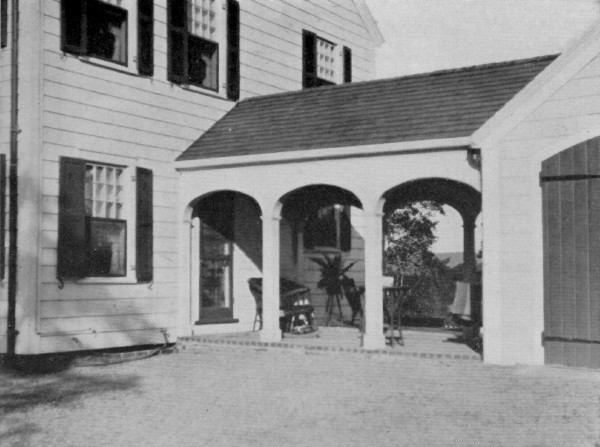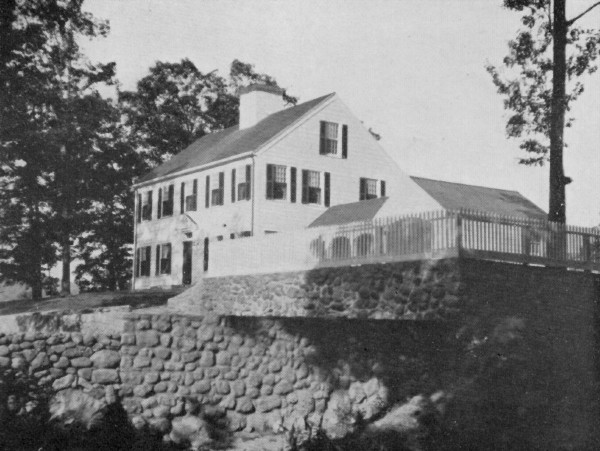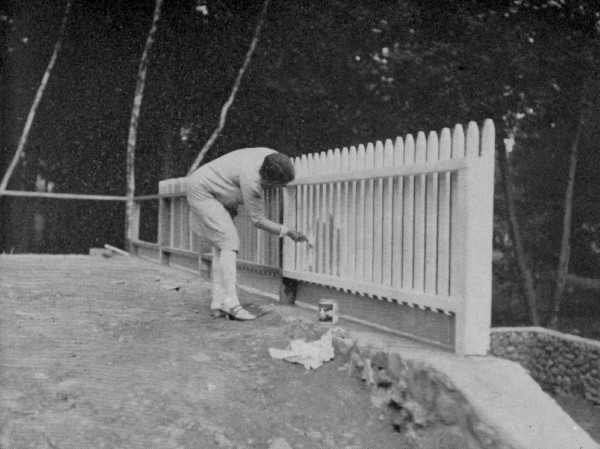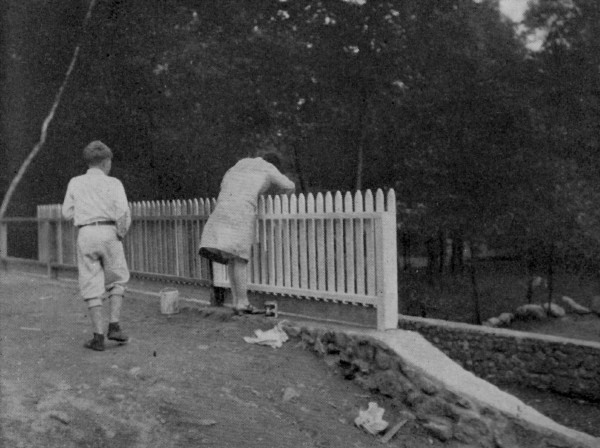| Web
and Book design,
Copyright, Kellscraft Studio 1999-2012 (Return to Web Text-ures) |
 (HOME)
|
| CHAPTER
VII
YOU'LL HAVE TO SETTLE THESE THINGS BEFORE
house plans get
very far, there are some questions that must be settled. They may as
well be tackled, first as last. Here they are:
What kind of heating plant will you have — Steam, hot water, or hot air? What fuel will you use — coal, oil, or gas? What type of kitchen range will you have — coal, electric, or gas? How will you heat your water supply? What is to be the source of your water supply? What kind of an ice-box, old fashioned, electric, or gas? How will you dispose of waste water? I will take up some of these questions and tell how we settled them. Let's begin with the heating system, because that is the most debatable. I had stoked coal and ashes for twenty years. If there was any practical way to escape being nursemaid for a furnace, I wanted to know it. When I was away and the furnace man had an attack of rheumatism, my wife or a maid had to keep the furnace going. My wife was in thorough accord with the advertisement: "No coal shovel was ever made to fit a woman's hand." We knew that oil burners were satisfactory. There were forty installations of a single make in a town near where we lived. Many of my friends had them. The anthracite coal interests were beginning to feel the effect of oil burners. Every day coming in on the train huge billboards selling the merits of "dear old anthracite" greeted me. Their motto was, "The Unfailing Fuel." I wonder if the man who selected that slogan knows any more jokes. We had been through four coal strikes in a dozen years. In the last one we were forced to burn almost everything burnable to keep from freezing. "The Unfailing Fuel" hasn't made a very high batting average in recent years. We tried burning coke, but in addition to burning out my grate, the kind of coke we used gave the furnace a case of halitosis that even our best friend, the coal dealer, wouldn't mention. We tried bituminous coal, the kind that playfully shoots a huge tongue of burning brimstone into your face with every shovel full. We tried cordwood, logs, and cannel coal. Before this strike ended, we were on the point of ripping down one side of the coal bin and burning that, as they did in Jules Verne's story, ''Around the World in Eighty Days," where they finally made port by burning up part of the ship. We certainly did not care to risk another coal strike. Operators say there will not be any more. In the old Weber and Fields days, Lou Fields told Joe Weber that a barking dog never bites. But Joe wasn't convinced. He said, "Yes! Lou, you and I may know that, but how about the dog — does he know it?" Perhaps the miners haven't been consulted about never having another strike. I obtained a list of oil burners in New York and was amazed to find so many. In shopping around, the first clerk I encountered was soon deep in a discussion about atomizers, 26° Baume oil and complete combustion. He talked so fast that the best I could do was to nod my head in complete agreement with him. What most of it was about, I don't know even yet except that with about fifteen hundred oil burners on the market, his burner had some gadget that none of the rest had. In my anxiety to appear intelligent, I completely forgot to ask him what his burner cost, which was really my principal object in calling. I tried a second company. But this clerk was also a combustion and atomizing addict too. His principal obsessions seemed to be B.T.U's and calories. Before that, I always had a vague impression that calories were something to eat, but it seems not. They are something you get when you buy a Beelzebub Oil Burner. I finally did get in a word by asking: "How about the Hot Dog Burner. I hear that is pretty good, too?" That was enough. He drew himself up to his full height, meanwhile assuming a Mona Lisa expression. Then came the dirty dig: ''Oh, we never knock our competitors, but — " Then he told me of dozens of places where they had taken out Hot Dogs and installed Beelzebubs. He casually mentioned some fires in East Orange, New Jersey, Greenwich, Connecticut and other places caused by some defect in the Hot Dog which the Beelzebub overcame. That was discouraging as a similar line of salesmanship happened in several other places. I was beginning to wonder whether that was a part of the ethics of oil burner selling, or whether there might not be something wrong with oil burners themselves. But even with these misgivings, I could still look nonchalantly at the anthracite posters with the big brave father protecting mother and the kiddies by buying them anthracite coal — "The Unfailing Fuel." After a canvass of oil burners, I was still in the dark. Then I decided to "ask the man that owns one." This brought out the fact that oil burner users are usually enthusiasts. I failed to find one that would willingly have gone back to coal. There was a feeling that possibly the burner they had might not be the best one. I imagine that would apply to anything — automobiles, radio sets or aeroplanes. There was some objection to noise. No one said that oil cost less than coal. I had about decided to install an oil burner, when I happened to meet a man who had a gas-fired boiler. If there was any earthly virtue that this type of boiler failed to possess, he couldn't think of it just then. He probably has stock in the local gas company. I guess he needs it. With gas burners I found a different situation than exists in the oil burner industry. In my neighborhood, gas-fired boilers are sold by the local gas company. They handle several brands and seem to think they are all good. Their salesman frankly told me that to heat with gas would cost about double that of coal. As I intended to insulate the house thoroughly, and on the theory that ''fools rush in where angels fear to tread," I placed my order for a gas-fired boiler. At the time that this is being written, I am unable to say how much gas heat will cost. It isn't costing much to-day. (Whew! but writing a book is a hot job in August). The convenience of gas (or oil too, for that matter) is a refreshing adventure in contentment for anyone who has depended upon coal. No ashes, no dust, no trucks ruining your lawn. The cellar is as clean as any room in the house. When the first cool days come along in October, you wind your thermostatic clock, light your pilot light, and the gas meter takes care of the rest. (I'll say it does.) That's all there is to it. Your visits to the cellar are merely to show this wonder of a furnace to your friends. The thermostat turns on the heat at five A.M. It turns it back to 60° at ten o'clock, or whatever hour you set it for. In the morning the house is as warm as when you retired. If someone will invent something that will also close windows in the morning, then household heat will be perfect. Why not get Goldberg to work on it. Cat ''A" could scratch on door ''B" to get in, making dog "C" bark and tug on his chain, thereby making weight "D" close the window. Another good way is to get up and close them yourself. But there seems to be a question whose job that is in most families. Perhaps the World Court will settle it. After gas fuel was decided on, the next question was whether to have steam, hot water or hot air. Hot-water heat has many advocates. My own experience had chiefly been with steam. Once we had a hot-air furnace. Never again for me. It was all right unless the wind happened to get in the Northeast and brought a blizzard whirling down through the trees. Then we wore overcoats and sweaters in the house until the wind changed. Steam heat is great when pressure is up. But even with a thermostat I could never get the thing to work with coal in the early morning. No matter how carefully I banked the fires, it would burn out before morning. A house should have adequate radiation to keep it at seventy degrees on a zero day. But how about the days that are not zero? The mean average winter temperature where we live is around forty degrees. That would mean, except in extremely cold weather, too much heat when steam was up and none at all when it was down. Hot-water heat costs more to install than steam — two pipes instead of one, and larger radiators. It is slower to heat up, but against these objections are advantages that it requires less fuel, it is steady heat, and it is absolutely noiseless. We decided upon hot-water heat and submitted our plans to a heating engineer to figure the radiation. He looked them over, hemmed and hawed a lot about windows and began his calculations. In fact, he said so much about windows that I was tempted to cut out about half of them. There is a greater heat loss through windows than through the side of a house, I realized that, but even a heating engineer must agree that windows admit more light. It seems that windows require some sort of abstruse algebraic calculations. When he gave me a statement of the radiation necessary, it looked like a lot to me. I had a second heating engineer check his figures. This man gave me an entirely different set of figures and remarked that the first heating engineer was full of little red ants. These figures called for about half the radiation of the first heating engineer. I asked him how it was with thousands of houses of the same general shape and size as mine, that such profound calculations were necessary anyway. He did not seem to have an answer for that. Finally I appealed to the manufacturer of the gas boiler I intended using. His experts made still a third set of figures, and guaranteed that he would keep the house at seventy degrees. That was enough for me. I accepted his figures. The heating question settled, next came the kitchen range. We had used all three types, coal, gas and electric. The two last named are infinitely superior in convenience to coal. While we decided on a gas range, in making this decision I said ''good-bye" to having a broiled steak taste as it does when cooked over coal. You simply can't get that smoky delicious flavor that coal gives on a gas range. Possibly someone will invent a gas steak-broiler that will make a beefsteak taste like a beefsteak, and not like those baked funeral meats common to the early Egyptians. In selecting the gas range I thought of those thousands of hods of coal and pails of ashes that someone has to juggle with, those twenty-one meals a week, 1,092 a year, dust, soot, heat, smoke and grime. Until recently there has been but little improvement in cooking since the Stone Age. I imagine the Troglodyte had just as savory a Dinosaur steak broiled over hickory coals as we have to-day. But with the fireless cookers and thermostats, modern cooking gives a woman time for more useful pursuits. And it should. You put your roast in the oven, set the hand to ''roast five pounds," cook vegetables without water, and after eighteen holes of golf or a matinee, everything is done to a turn. This culinary glimpse of Heaven was formerly the exclusive property of the electric range. Now it has been applied to gas. We decided upon a thermostatic gas range with a ''fireless cooker" attachment. It is a complete success.
 Our Flat Arches are seen in New England Houses as early as 1650.  A double decked Stone Wall with a Sunken Garden in front. This Wall might be whitewashed to preserve the Colonial spirit. It will eventually be covered with Boston Ivy and have Hollyhocks peeping over the top.   Picket Fences are almost a necessary adjunct to Early Houses. This is one way to get them painted.
When you install a coal range, household hot water is no problem because water is heated by means of a water-back built right into the fire box of the range. But if you plan to use a gas or an electric range, a real problem is present. Then you will be obliged to provide a separate heating unit for hot water. Sometimes this is built into the furnace or boiler. But, manifestly, such an arrangement is only useful when the weather requires artificial heat in the house. There are also various types of electric water heaters, which are automatic and expensive to operate. It has been claimed that, in current consumption, it costs more to heat a trolley car than to run it. Whether this is true or not, electric heating is expensive and for that reason unusual. In this connection, it may be interesting to note that recently a device has been invented which will heat household water only during the time of day when current consumption from a central power house is at a low ebb — at noon for example or in the early morning. The water thus heated is stored in a sort of vacuum bottle type of boiler to be used when required. We don't know anything about its merits, but it sounds reasonable. The power house makes a special low rate for this gadget. For our house, we decided upon an automatic gas heater attached to a 30-gallon boiler. We took the additional precaution of securing a copper boiler instead of galvanized iron, because all of our water pipes are brass. With an iron boiler, we should have provided a source for rusty water at the very point where it should have been avoided — namely where the water was stored. After a year of unfailing service, this water heater hasn't caused the slightest trouble. We have had an abundant supply of hot water at all times — even on Saturday night. When the supply falls below a certain temperature, a pilot light and a thermostat go into a huddle and provide more — and that's all there is to it. If you plan to build outside the zone of a public water supply you are now talking to a man who has spent more energy fighting balky pumps than a crew of shipwrecked sailors. Running water is probably the most important item of service that your house will need. It must be potable to begin with, or you are in for a lot of trouble. Potability means a well, either dug or driven, a spring or a mountain brook. It doesn't mean a mill pond or a lake surrounded by cottages and possible contamination. Driven wells cost a lot of money, as much sometimes as $10 a foot, and it is a common experience to require 100 feet of driving before an adequate supply can be reached. Don't pay too much attention to the old snoozer in your town who claims to locate a good stream of underground water with a forked peach branch or witch hazel rod. He is like the chap who predicts war because locusts have a "V" on their heads. They always have this "V," and there is water everywhere underground if you dig far enough. The "peach-tree" test is like the Ouija Board of a few years back that gave tangible expression to automatic writing. When your water wizard feels that the spot he is on is a likely place for water, he subconsciously twists his magic wand. The well is dug. Water is found. But that doesn't prove that it wouldn't be found at another spot where he has no such subconscious urge. Find out local conditions from people who have dug or driven wells. That will be your surest bet. After you get your water supply, the next question is, how to get it in your house. The worst way is to depend upon a windmill and an outside elevated tank. I have fought more windmills than Don Quixote. The best way is a pressure tank buried outside in the ground or in the cellar, and with a self-starting, automatic electric pump. One pound of pressure will lift water 2 1/2 feet. Therefore the working limits of a system with possibly a twenty-five foot lift is between ten and thirty pounds pressure. Your electric pump working on automatic control starts pumping at ten pounds and cuts off at thirty pounds. It requires but little attention except an occasional oiling. If you are beyond the zone of electricity, a gasoline pump is next best, but it requires constant attention as it will not start itself. The electric pump robs the Saturday night bath of the feeling that you are cheating the widows and orphans to take it. "Don't waste water" is a terrible inhibition to live under. The guest who gaily runs the morning tub, warbling as he bathes, may have song in his heart but there will be none in yours unless you have a good water supply. You can't teach an old dog new tricks, neither can you teach a city guest or a city maid not to waste water. It is no fun to act as watch dog for a water supply. Some people are lucky enough to have a gravity supply where some brook or spring higher than their house is tapped. A friend has such an arrangement. He dammed up a brook and piped the water by gravity down the bed of the brook across his garden and into his house. Then winter came along and one day when the papers said something about it being twenty below zero in Malone ("why is Malone such a cold place anyway"?) his water pipes froze solid and stayed frozen until April. He was forced to close up his place, all because he had failed to bury his pipes at least four feet underground. A good water supply is one of the greatest blessings of a country place. Modern engineering has gone a million miles from the days of the horse trough or old oaken bucket. Don't fail to study this question thoroughly and arrive at a solution that will give you plenty of water. In these days of automatic refrigeration, it doesn't require much argument to convince the average housekeeper that a mechanical ice man is better than a reformed burglar who takes up the ice racket in his odd moments, prowling around the kitchen door and tracking mud and water over the freshly scrubbed floors. Then also it says good-bye to that invention of the evil one, the drip pan which was always becoming overflowed just when the bridge party were demanding admittance at the front door. The only question that confronted us was which of the many types of automatic refrigerators to select. There were two choices, those that operate by electricity, and those that operate by gas. We selected one of the best known electric makes, but any one of a dozen other makes has its rooters, just as do the various makes of automobiles. There is still another type which — if you are beyond the zone of electricity or gas — operates by kerosene. But, while we are sold on electric refrigeration, if the manufacturers want a 100% testimonial they can't get it from us — unless they will tell me how to get around this problem. It is far more trouble to get a cube of ice from an automatic ice box for a glass of drinking water than to seize the trusty ice pick and with a few well directed blows break off a piece of ice as big as your head. Making ice cream is entirely out of the question. With ice cubes, you are constantly running out of ice when you have a party, long before the other necessary ingredients are gone. But as people are getting used to this situation, it is becoming a growing custom to ask your prospective guests to bring a few cubes from their own ice box when they call. But no one who has ever tasted the real joy, day in and day out, of an electric refrigerator would ever go back to the messy old ice box, even if he had to serve an occasional glass of ginger ale with pieces of glass ice as a substitute. And besides that, the local ice man is always available for emergencies. In every house outside the zone of public sewers, a waste water disposal plant must be provided. Without exception, there has been no department of house-building that has caused the writer more grief than sewage disposal. It isn't a pleasant subject to discuss but, like the "avoid that future shadow" cigarette campaign, it is just as well to look at facts. When a house is built on a clay subsoil without adequate drainage you are in for a lot of woe with an improperly constructed cesspool. But the answer is easy. To-day, the old-fashioned stoned-up basin with logs laid across the top is as obsolete as a feather bed. The modern system consists of a so-called septic tank which by some mysterious action of a colony of friendly bacteria destroys all the grease and solid matter and permits clean water to flow out of the tank. This water is then led into a tile drainage system with as many ''y's" as a Yale football team. At the end of each of these branches, a little stoned-up basin permits the water to soak away. The whole problem is to be sure you have sufficient fall, because water will not run up hill, and to provide as many of these branches as is necessary. Then your sewage disposal problem is solved for all time. I once provided such a system for a hotel of 100 rooms and after ten years, it has never caused the slightest trouble. |